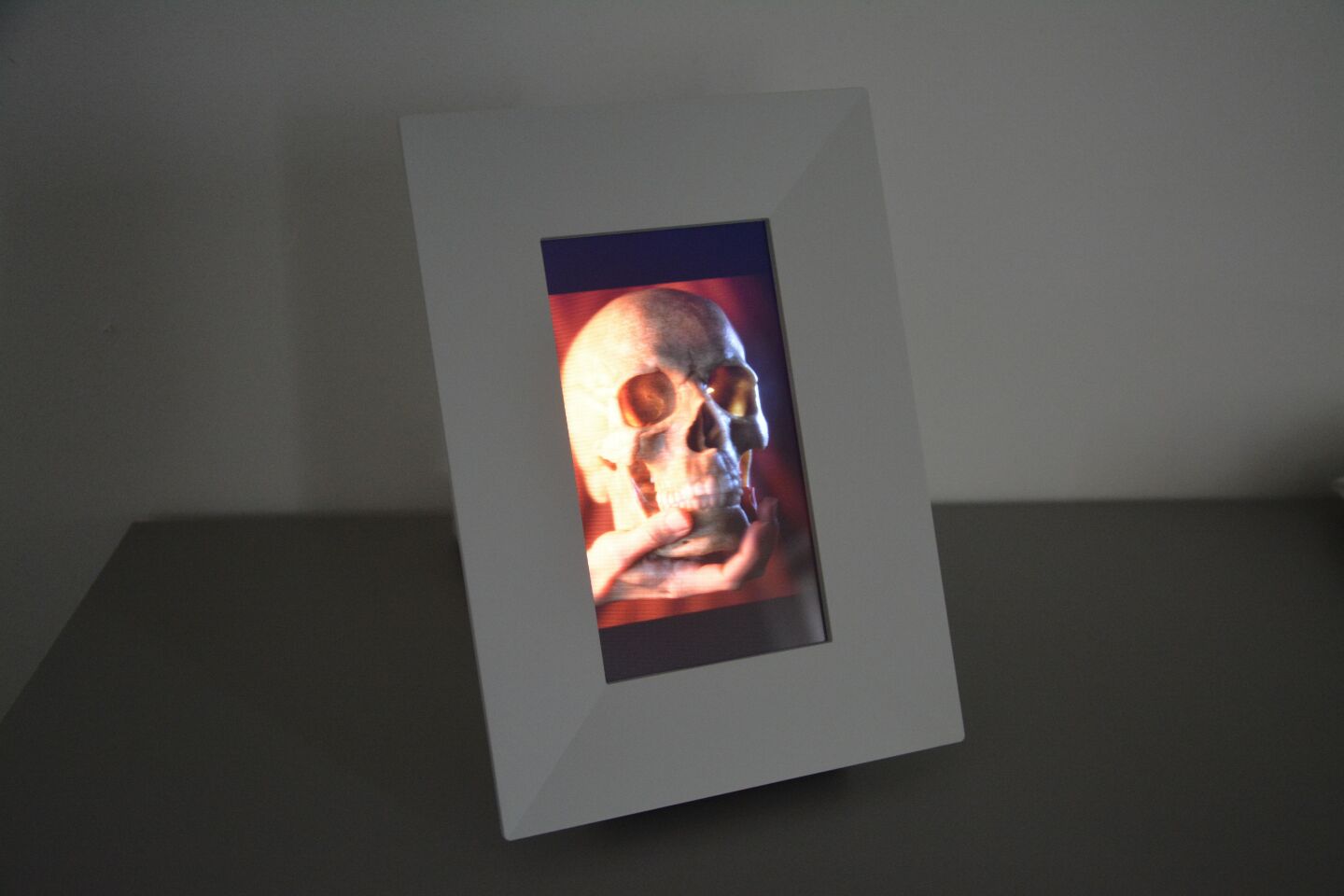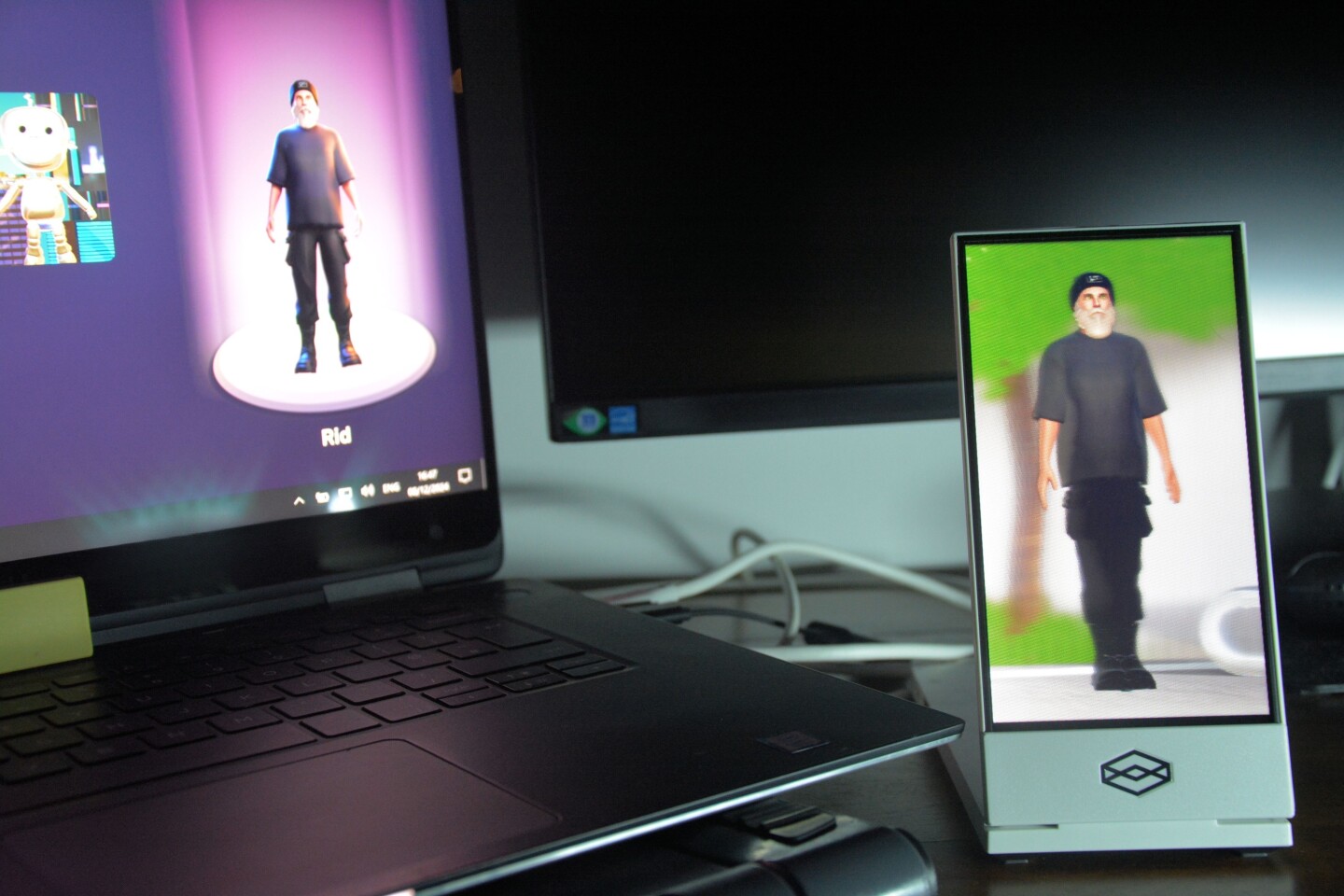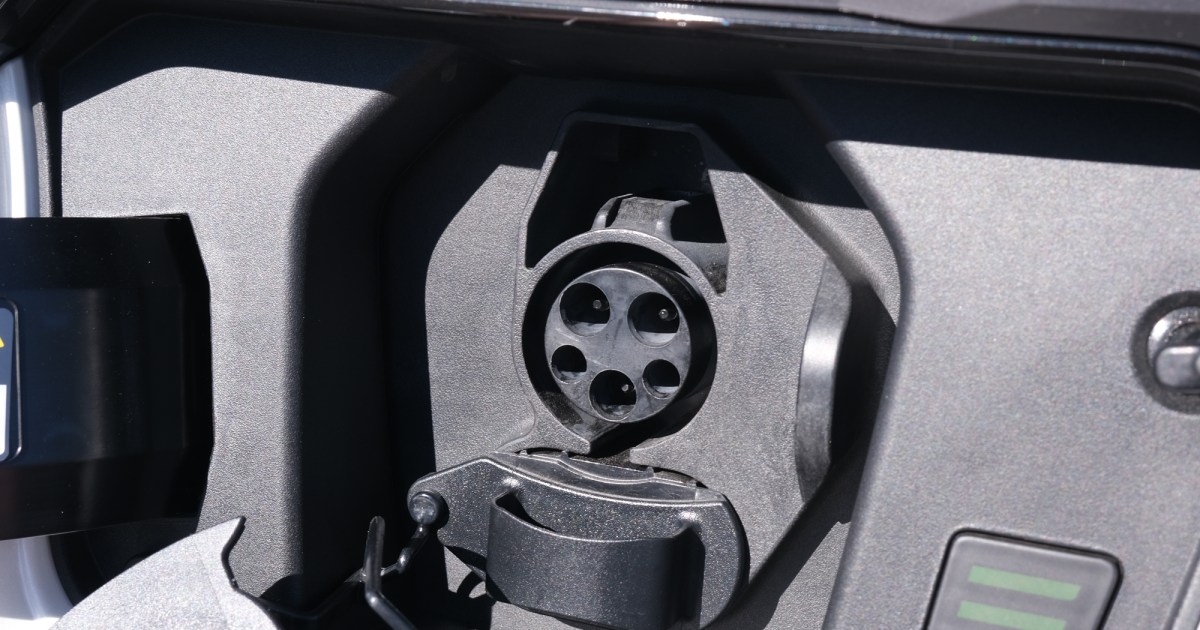Last year, the Looking Glass Factory launched a Kickstarter for a portable “holographic” display that shows three-dimensional imagery without requiring the viewer to don funky glasses. Now the Go is in the wild and we’ve been sent one to try out.
The Looking Glass Factory was founded by Shawn Frayne just over 10 years ago, and took to Kickstarter to get its “volumetric printing service” off the ground. This essentially sliced a 3D model and printed each slice in lucite, before bringing them all together to form a solid transparent block with the complete 3D model suspended inside.
Later that year, the startup returned to the crowdfunding platform with a hacktastic LED-packed cube for displaying images and animations in 3D. Things seemed to go quiet for a while, and then another Kickstarter went live in July 2018, this time for a chunky holographic display aimed at 3D creators. We’re not talking Star Wars holograms in mid-air here, but display technology that allows users to view three-dimensional visuals without needing to wear glasses or headsets, or employ head-tracking technologies.
A Pro workstation for business users followed about a year later, with a 15.6-inch touch display for viewing and manipulating 3D visuals plus a secondary control screen for navigation. A larger, higher-resolution model was reveled in late 2019, boasting an image depth measured in feet rather than inches, and designed for retail, mapping, medical imaging and entertainment applications. Neither of these models was pitched on crowdfunding platforms.
A personal lightfield device featuring a 7.9-inch display at 4:3 aspect became the company’s fourth Kickstarter in 2020, with the Looking Glass Factory hoping to get the attention of fellow 3D enthusiasts as well as artists, designers, developers, filmmakers and photographers. And the plan seems to have worked, as the project attracted more than US$2.5 million in funding.
The Looking Glass Factory
That brief history all-but brings us up to date, with last year’s Kickstarter for the Looking Glass Go – a slimmed down “holographic” display device that merges spatial technologies with artificial intelligence “and wraps them into an insanely compact system you can use anywhere.”
Ready, steady, Go
Like its other “hologram” products, the Go is built around proprietary hardware and software “to offer a highly comfortable and accessible experience, allowing multiple viewers to simply look at a display to experience real 3D content at the same time.” For those who likes deeper dives, the company has penned a more detailed look at how its systems work, which can be viewed here.
For other displays in the Looking Glass product arsenal, fairly powerful computer processing will likely be needed, but the spatial photo frame we’re reviewing only requires a mobile app for Android or iOS to convert two-dimensional photos and images into something with a bit more depth.
Using photos I had snapped on my smartphone or via digital cameras, the companion app took between 20 seconds to over a minute to perform each AI-powered conversion on my cheap Android handset, though more capable handsets might result in less of a wait.
Converted images can be edited for focus (which essentially tells the AI which part of the image you want in sharp focus) and depth via onscreen sliders, and you can zoom in if needed. A useful crop feature is planned for future implementation.

Paul Ridden/New Atlas
I found that some conversions were more eye-popping than others on the Go’s display – an arty shot of a tree branch in front of a house in portrait orientation, for example, had much more depth to it than a busy crowd scene. Also, if you generally prefer to snap your photos in landscape view, then results on the Go’s display will probably disappoint – as, unless you can crop a tasty section to be more portrait-friendly in editing software, the image will be squished into a letterbox rocking large black borders top and bottom.
Once you have a few spatial images banked up, these can be saved to playlists, which are also backed up to the Looking Glass cloud. These depth-charged spatial images can then be automatically or manually sent over Wi-Fi to the Go for display. Loading in one by one can take a minute or three though, and you may as well go make a cuppa if you have multiple images to send over.
While the Portrait before it had significant girth to accommodate its “holographic” technology as well as a more tablet-like 7.9-inch display, the company has managed to slim things down considerably with the Go. Its smartphone-like 6-inch screen is just 0.24 inches thin (6.2 mm) – though when laid flat against its base that increases to 0.76 inches (19 mm).
“The magic of the display’s slimness is both a factor of advances in screen technology as well as in our software stack, which enables us to produce lightfield holograms on displays with a thinner form factor,” the Looking Glass Factory told us.
There’s a smooth-action hinge at the bottom edge of the display that allows for adjustment from flat (horizontal) to 90 degrees (vertical), or anywhere in between. Display resolution is reported to be 1,440 x 2,560 pixels with an 8-bit color depth, and the screen refreshes at 60 times per second. That might look like smartphone-like specs on paper, but the spatial effect does have an impact on the definition of what you actually see.
Through the Looking Glass
The optimal viewing angle for gawping at your spatial creations runs over a 58-degree viewing cone. Move outside of that cone, and the imagery gets bent out of shape before quickly fading to black. Viewers can also get as close as an inch away if they really want to, though about 10-12 inches from screen to eyes yielded the best results for me. The system also allows a number of people to gather around the screen to view the 3D imagery simultaneously.

The Looking Glass Factory
What viewers actually see on the display doesn’t translate well to static photos or even video, so I’ll attempt to explain my experience in words. Looking straight on, the part of an image selected during focus tweaking remains pretty much, well, in focus while what’s behind gets more blurred the farther it goes into the background.
Changing perspective by moving my view to the left or right makes the 3D-ness of the conversions more pronounced, with subjects appearing to gain depth. The converted photo of that tree, for example, has leaves to the front really popping (though the illusion doesn’t make it appear as though the image is breaking out of the front of the screen) while those behind are less defined, and altering my viewing angle hides some of the branches behind in-focus foliage while also slightly shifting the view of the house in the background.
However, rather the offering fluid depth throughout the image, a busy restaurant scene was given the appearance of a pop-up children’s book – where people in front were placed on one flat layer, those slightly behind on another, and others in the background on yet another.
I also found that the algorithms had occasional misfires, possibly as a result of imprecise focus during image creation. This resulted in an ear of a pooch becoming detached in front of my eyes and floating away from her head as I altered my viewing angle, an actual beheading in a party scene, and a seagull suddenly growing a triple beak. On the whole though, I was impressed by the system’s conversions and they certainly provided a new focal point for visitors.

The Looking Glass Factory
The Go includes around 23 GB of accessible onboard storage, which is reckoned enough to host “thousands of holograms.” At first power on, the device will showcase a number of example visuals that draw you into the Looking Glass universe even before you start filling up its memory with your own images (once you load in your own spatial creations, the default set is no longer available).
All of these and more are available through the Blocks desktop application for Windows, Mac and Linux, where you can add publicly shared images and digital artworks to your own playlists, or make your creations public for others to enjoy. Any updates to playlists made in Blocks will save to cloud storage and sync to the Go next time it’s connected.
If you can’t wait that long, a desktop mode is available for cabled connection to your computer/laptop over USB-C – though you will need to download the Looking Glass Bridge software to serve as go-between.
I found both the mobile and desktop applications pretty easy and intuitive to use, though there’s more functionality on offer through the latter. Virtual artists will also appreciate the ecosystem’s compatibility with the Blender modeling tools and Gaussian Splats, and there’s also support for apps developed using the Unreal engine and Unity.
Chatting with chatGPT, and yourself

Paul Ridden/New Atlas
Keeping things fresh and futuristic, the Looking Glass Factory has also introduced something called Liteforms. This is a desktop app for recent Mac and Windows systems that allows users to chat with a GPT-enabled character or avatar on the Go device.
As with the Blocks application, the Bridge software need to be active and the Go cabled to a DisplayPort USB-C to run in desktop mode. Once logged in, three default Liteforms are available to chat with: the world-wise Uncle Rabbit, “an on-trend social media influencer” called Lil’ Inu, and “a southern-humored android with a taste for banter and desire for connection” named Android Andi.
Clicking on one of these characters will have it appear on the Go’s display, where it’s ready to chat, answer queries or generally behave like GPT, but in animated form. I found the default Liteforms to be an amusing yet clever way to engage with a chatbot, but felt a bit too old to be holding conversations with cutesy avatars.
Fortunately, the application also lets users set up custom characters, including ones based on uploaded photos. I named mine RidBot and was able to chat with a much more knowledgeable – and much more pleasant – version of myself. Perfect! Who needs real friends anyway?
The current Liteforms offering is limited to around 5 hours of usage per month, but the clock can be paused between chats.
Set it and forget it
Once a user has settled on a playlist for the Go, the device can cycle through its stored imagery on its own, without needing to have the apps running. The base has slim buttons for play/pause and forward/back – the display isn’t touch-enabled – but you’ll need to fire up and connect with the mobile or desktop apps to make changes or select new playlists/imagery of course.
The Go also sports a Type-A port to the left, which could potentially load in spatial images from a USB thumbdrive, though the company told us that it’s “still working on software to easily create a USB key with the necessary information.”
The Go ships with a long USB-C cable for power, but our review unit came with a 3,500-mAh Li-ion battery thrown in as well – for 2 hours of mobile use per charge. Our test package included the normally optional Frame too, for showing off the impressive technology in a more traditional photo frame format. This comes bundled with a wall mount, should you wish to showcase your playlist among your other framed memories.

Paul Ridden/New Atlas
The bottom line
Do you remember digital photo frames taking the world by storm in the 1990s. They allowed you to plug in a memory card from your camera or drag-and-drop images into included storage, and would display a treasured memory for a few seconds before moving to the next in the queue.
Though everyone seemed to have one for a while, people soon tired of having to update the selection with new holiday snaps or special occasions. Plus smartphones arrived to serve as both camera, archive and display. As such, photo frames went out of favor and ended up stuffed in a drawer – unused and unloved.
The Looking Glass Go adds another dimension to the old photo frame, makes updating much less of a chore, and brings chatbots to life – and functionality/features will only improve over time as updates become available.
In its current form, I can see this being used at a museum reception, where a 3D chatbot avatar could welcome visitors and answer queries – all while introducing an extra level of “wow” to the institution. Retail stores could also benefit from adding another dimension to product displays or checkout desks, though the device doesn’t come with a lock slot for easy security so store owners will have to get inventive or risk opportunist theft.
Artists could showcase works, it might serve engineers and designers well too, and 3D nerds can, well, nerd out to their heart’s content. Regular Joes like me can simply bring something extra to family photos on display in the living room or, with the addition of the battery pack, take the spatial image show on the road.

Paul Ridden/New Atlas
So will it suffer the same “novelty factor” fate as digital photo frames? Maybe. But the Looking Glass Factory continues to develop new ways to keep users engaged and improve the experience. In fact, from today the company is introducing support for iPhone and iPad to all of its displays.
“We are at an exciting crossroads where mobile technology meets 3D display,” said Rob Kodadek, COO of Looking Glass. “With iOS support, creators and app developers now have a new way to bring media and interactive applications to life and share them in 3D, with a drastic reduction in gear.”
For the Go, this means that an iPhone or iPad can not only run real-time applications and 3D content on the device’s display, but can also provide power. An upcoming video player will allow iPhone 15 (or newer) users “to transform their cinematic videos into holographic media that can be displayed in 3D” on the Go. These videos can then be shared with others. A beta version of this app will be released in January, but the short video below shows what to expect.
Looking Glass Displays now with iOS support
Creative studio Gukenka will be the first company to bring a third-party app to the Looking Glass universe. Its 3D HoloModels avatars will be available to iOS users for display on the Go. The Looking Glass Factory will be showcasing its current and upcoming technologies and applications at CES 2025 in January.
Rounding out this review, despite a few blips along the way I’m impressed with what’s currently possible with the Looking Glass Go and intrigued by what’s to come.
Spatial imagery on your desk and Liteforms chatbotting don’t come cheap though. A Go device on its own (well, with USB-C cable, power adapter, microfiber cloth and stickers) is priced at US$299. If you want to go totally mobile with the battery pack then that will cost you an extra $30. Framing your device adds another $30 to the pot, and a fabric carry case completes the accessory checkout cart for $25 more.
Product page: Looking Glass Go







